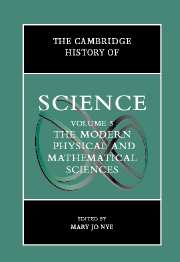Book contents
- Frontmatter
- Introduction: The Modern Physical and Mathematical Sciences
- Part I The Public Cultures of the Physical Sciences After 1800
- Part II Discipline Building in the Sciences: Places, Instruments, Communication
- Part III Chemistry and Physics: Problems Through the Early 1900s
- Part IV Atomic and Molecular Sciences in the Twentieth Century
- Part V Mathematics, Astronomy, and Cosmology Since the Eighteenth Century
- Part VI Problems and Promises at the End of the Twentieth Century
- 29 Science, Technology, and War
- 30 Science, Ideology, and the State
- 31 Computer Science and the Computer Revolution
- 32 The Physical Sciences and the Physician’s Eye: Dissolving Disciplinary Boundaries
- 33 Global Environmental Change and the History of Science
- Index
- References
33 - Global Environmental Change and the History of Science
from Part VI - Problems and Promises at the End of the Twentieth Century
Published online by Cambridge University Press: 28 March 2008
- Frontmatter
- Introduction: The Modern Physical and Mathematical Sciences
- Part I The Public Cultures of the Physical Sciences After 1800
- Part II Discipline Building in the Sciences: Places, Instruments, Communication
- Part III Chemistry and Physics: Problems Through the Early 1900s
- Part IV Atomic and Molecular Sciences in the Twentieth Century
- Part V Mathematics, Astronomy, and Cosmology Since the Eighteenth Century
- Part VI Problems and Promises at the End of the Twentieth Century
- 29 Science, Technology, and War
- 30 Science, Ideology, and the State
- 31 Computer Science and the Computer Revolution
- 32 The Physical Sciences and the Physician’s Eye: Dissolving Disciplinary Boundaries
- 33 Global Environmental Change and the History of Science
- Index
- References
Summary
“Global environmental change,” three words heard with increasing frequency in both science and policy circles, is shorthand for the inevitability of change in the geosphere-biosphere. It also expresses the realization that human activities have now reached the level of a planetary force. Since 1945, we have grown increasingly apprehensive about a number of global environmental issues, including population, energy consumption, pollution, and the health of the biosphere. At the beginning of a new millennium, instead of standing firmly on the technoscientific foundations of our “enlightened” predecessors, we find ourselves apprehensive about global environmental change, teetering on the uncertainties of a new century and unsure about the future quality and even habitability of the global environment.
Much of the concern is rightfully focused on changes in the atmosphere caused by human activities. Only a century after the discovery of the stratosphere, only five decades after the invention of chlorofluorocarbons (CFCs), and only two decades after atmospheric chemists warned of the destructive nature of chlorine and other compounds, we fear that ozone in the stratosphere is being damaged by human activity. Only a century after the first models of the carbon cycle were developed, only three decades after regular carbon dioxide (CO,) measurements began at Mauna Loa Observatory, and only two decades after climate modelers first doubled the CO, in a computerized atmosphere, we fear that the earth may experience a sudden and possibly catastrophic warming caused by industrial pollution.
- Type
- Chapter
- Information
- The Cambridge History of Science , pp. 634 - 650Publisher: Cambridge University PressPrint publication year: 2002



